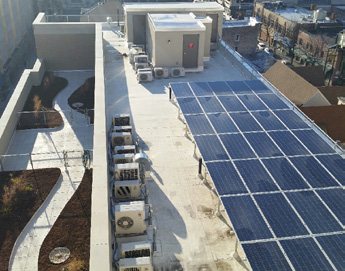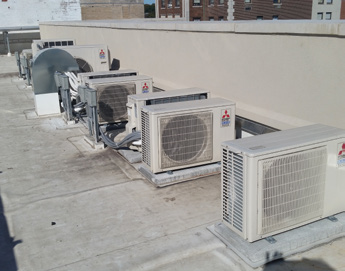Floodproofing.
Decentralized and high-efficiency heating and cooling systems distributed throughout a building can help avoid flood damage while lowering operating costs. Distributed systems are most effective in buildings with high-performance windows and well-insulated, airtight envelopes.
Description + function
Distributed systems provide heating and cooling inside a residential unit, giving residents greater control over the temperature in their apartment and dramatically reducing distribution losses. Dedicated boilers, warm-air furnaces, window-mounted air conditioners or through-the-wall heating/cooling units can be installed in individual apartments. Air-source variable refrigerant flow (VRF) units, also known as mini-splits, are a newly viable option for residential multifamily buildings. A split system locates some hardware indoors and some outdoors. Mini-splits are much smaller than commercial split systems.
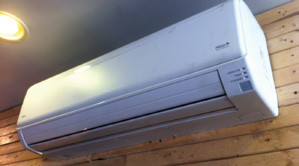
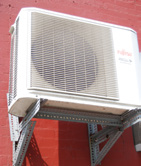
Until recently, VRF units were not very efficient, especially in colder climates. New units work much better, even in northern areas.
Conversion from a central to a distributed system provides many advantages:
- Virtually eliminates flood risk because almost all the equipment is located above the basement.
- Improves climate control efficiency by heating or cooling only spaces in use—not the entire building.
- Provides residents with a significantly greater control of temperature in their homes.
- Allows sub-metering of heating and cooling energy (where permitted by law).
Strategy into action
Outside condenser units can be mounted on raised platforms outside the building, on special brackets on exterior walls, or on the roof, depending on the building. All exterior units must be sufficiently anchored against high winds.
Connecting the inside and outside components of the mini-split system will require drilling through interior and sometimes, exterior walls.
Operations + maintenance
Residents who do not have air conditioning may have increased electricity costs with the installation of a sub-metered mini-split system. Tenants should be informed about how to operate their units cost-efficiently.
Mini-split maintenance includes cleaning filters and condenser coils, and regular refrigerant charge, and inspection of drain pan, blower wheel, fan, condensate tubing and electrical connection.
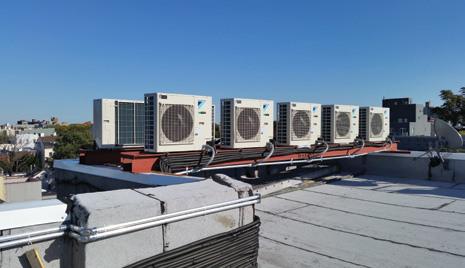
Estimated Cost
- $
- $$
- $$$
- $$$$
Supporting Strategies
Resources
- Air Conditioning Sizing Calculator. www.supplyhouse.com/pex/control/MiniSplitCalculator
- Comparison between Decentralized and Centralized Air Conditioning Systems, ILK Dresden. www.troxchina.com/xpool/download/en/technical_documents/air_water_systems/ilk_study.pdf
- Energy Star Guide to Heating and Cooling Systems. www.energystar.gov/ia/partners/publications/pubdocs/HeatingCoolingGuide%20FINAL_9-4-09.pdf
- Fuel Cost Calculator, BuildingGreen, Inc. www.buildinggreen.com/calc/fuel_cost.cfm
- Heating and Cooling Systems, Energy.gov. energy.gov/energysaver/home-heating-systems
Background
The Bluestone Organization pioneered the use of distributed heating and cooling in affordable multifamily housing at Norman Towers, a 101-unit building in Jamaica, Queens, NY.
Strategy
Each Norman Towers apartment has its own heat pump. External components of the distributed system are located on the roof and at ground level in a covered carport.
Bluestone paired the distributed heating and cooling system, with a high performance envelope to create low-energy, efficient housing. In case of a power outage, the building is sufficiently insulated to maintain livable temperatures in residents’ homes.
Cost
Installed cost for the mini-splits was $6,200 per unit.
